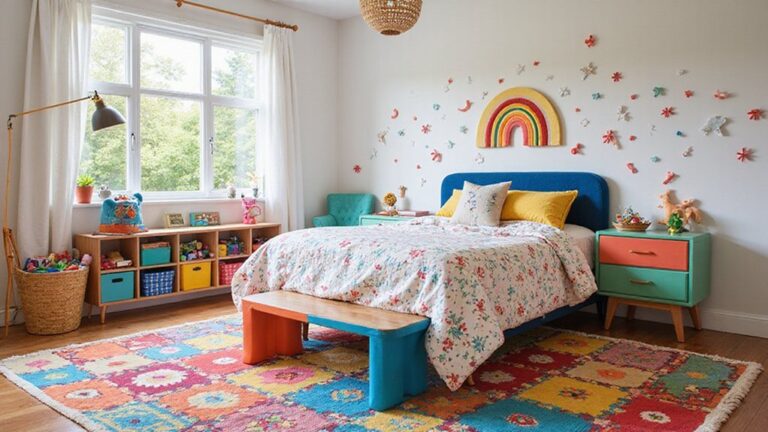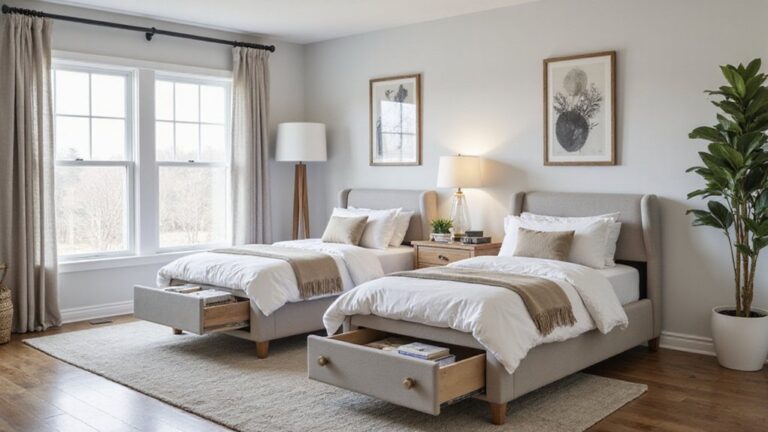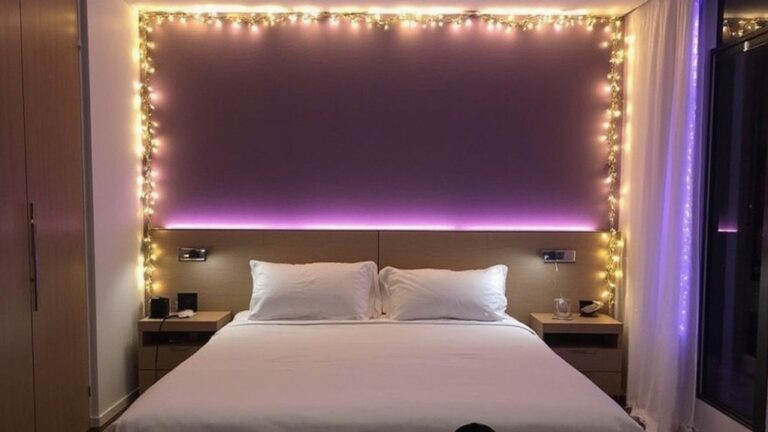Stop me if you’ve heard this one before: Two brothers sharing a room, constant arguing over whose stuff is whose, and parents losing their minds over the daily territorial disputes. I’ve watched countless families turn bedtime into a battlefield simply because they never cracked the code on shared bedroom harmony.
Here’s what nobody tells you about boys sharing rooms – the fighting isn’t really about space, it’s about respect and individual identity. After diving deep into this challenge, I discovered that most bedroom battles stem from boys feeling like they’re losing their personal territory and unique identity in the shuffle.
You’re about to learn the exact strategies that transform chaotic shared bedrooms into peaceful, organized sanctuaries where each boy feels valued and heard. These aren’t just pretty Pinterest ideas – they’re battle-tested solutions that tackle the root cause of sibling bedroom drama through distinct territories,personal ownership, andstrategic design choices**** that end the fighting for good.
Create Individual Territory With Room Dividers
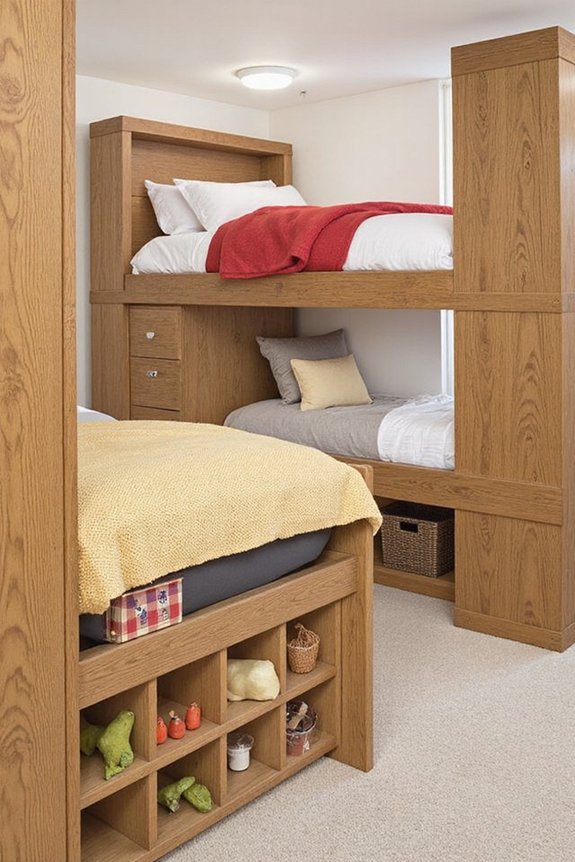
How can you give two boys their own space without building an extra wall? Room dividers create instant personal territories that reduce conflicts over space and belongings. Install a sliding barn door between beds, hang curtains from ceiling tracks, or position a tall bookshelf as a natural barrier.
Folding screens offer flexibility—boys can open them for playtime and close them for privacy. Consider a half-wall divider that maintains airflow while defining boundaries. These solutions let each child personalize their side, store private items, and retreat when needed, dramatically reducing territorial disputes in shared bedrooms.
Assign Each Boy His Own Color Scheme
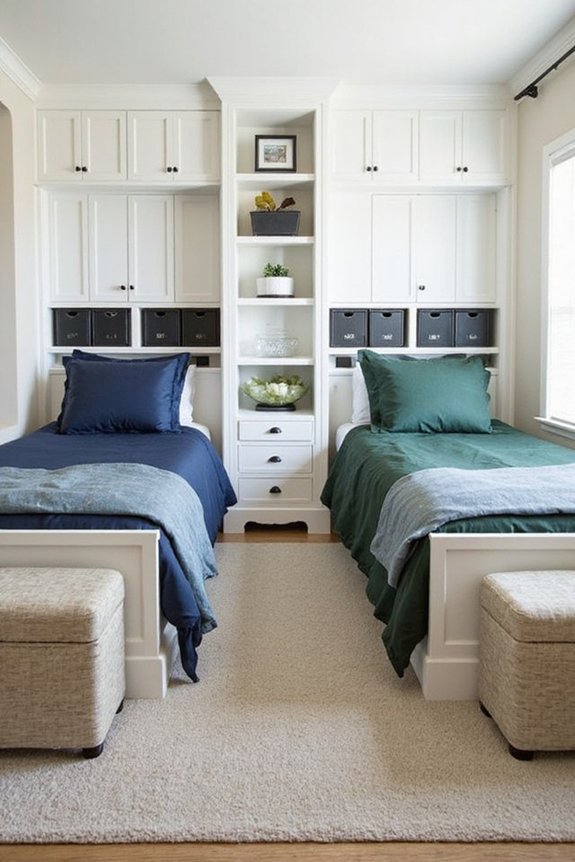
When brothers share a bedroom, assigning distinct color schemes prevents the “everything belongs to everyone” mentality that sparks daily arguments. You’ll create instant ownership when each boy gets his designated colors for bedding, storage bins, and personal items.
Choose contrasting colors like navy and orange, or green and gray to avoid confusion. Label each boy’s belongings with his assigned color through tape, stickers, or colored bins. This system works especially well for shared furniture—paint dresser drawers different colors or add colored knobs.
You’ll eliminate disputes over whose items belong where while teaching organizational skills.
Install Separate Storage Systems for Personal Belongings
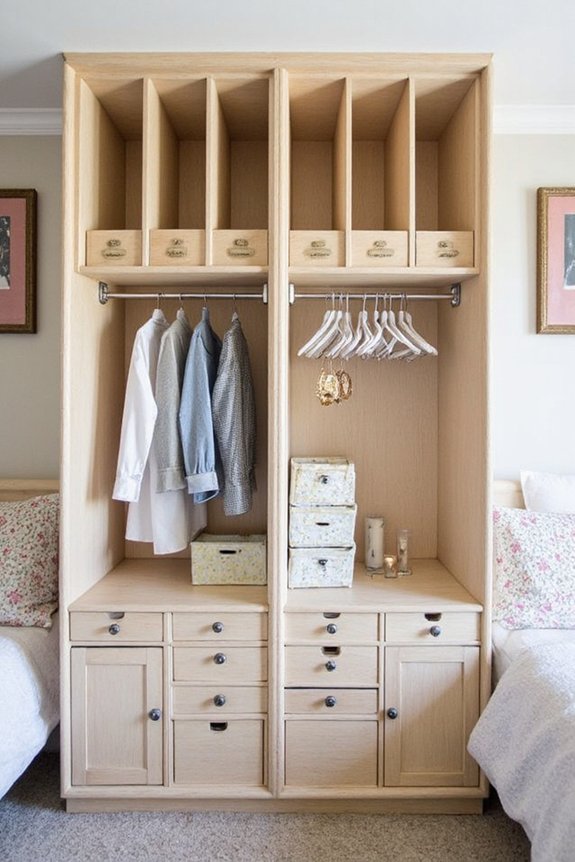
Color-coding personal items works best when each boy has dedicated space to store his belongings. You’ll eliminate arguments by creating separate storage zones that respect each child’s independence. Install individual storage solutions that give every boy complete ownership over his possessions.
Consider these effective storage options:
- Individual cubbies or lockers for school supplies and personal treasures
- Separate dresser drawers labeled with each child’s name or color
- Personal under-bed storage boxes for toys and collectibles
- Individual closet sections with designated hanging rods and shelves
You’ll reduce territorial disputes while teaching organizational skills that’ll benefit them throughout life.
Design Mirrored Spaces for Equal Treatment
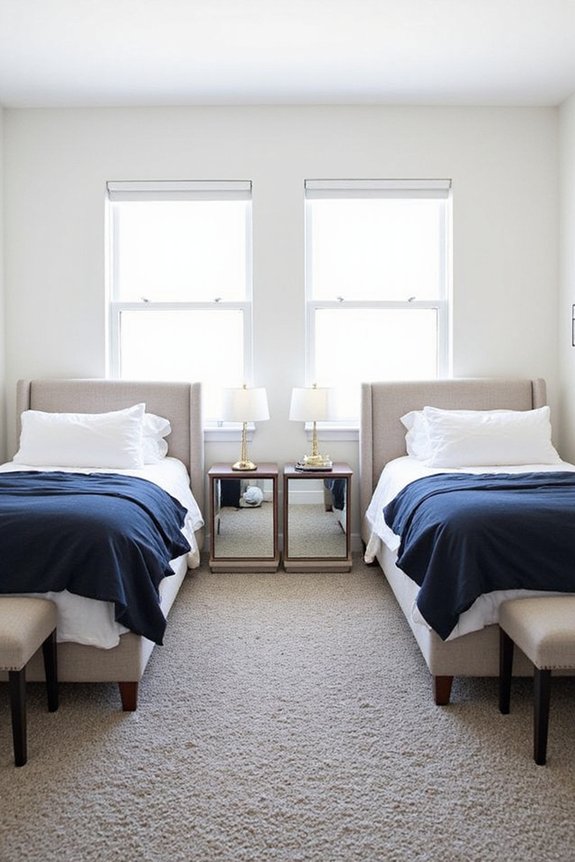
Creating identical spaces for each boy prevents jealousy and guarantees fairness in shared bedrooms. You’ll want to mirror everything from bed placement to desk positioning.
Install matching nightstands, lamps, and wall decorations on each side of the room. Choose identical bedding colors or let each boy pick from the same set of options. Position furniture symmetrically so neither child feels shortchanged.
Add matching bulletin boards, shelves, and storage cubbies at equal heights. This approach eliminates arguments about who got the “better” side and creates visual balance that’s pleasing to the eye while promoting harmony between siblings.
Establish a Neutral Common Area for Shared Activities
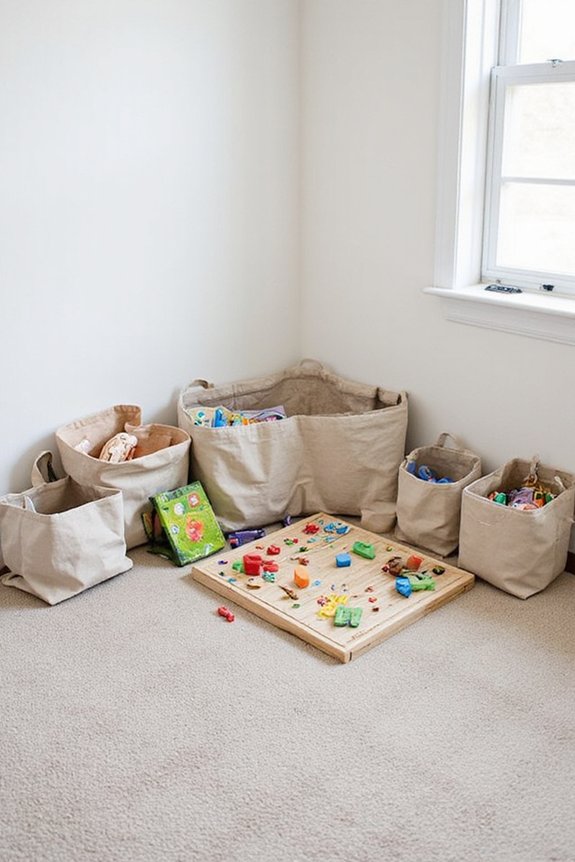
After establishing individual spaces, you’ll need to designate a central zone where both boys can play, study, or relax together. This neutral territory prevents disputes over ownership and encourages cooperation. Position this area between their personal spaces using furniture or rugs to define boundaries.
Create an inviting shared space with these elements:
- Storage ottoman that doubles as seating and holds communal toys or games
- Floor cushions for flexible seating arrangements during activities
- Shared bookshelf stocked with books both boys enjoy
- Activity table for homework, crafts, or board games
This common ground becomes their collaboration headquarters.
Use Bunk Beds to Maximize Floor Space and Privacy
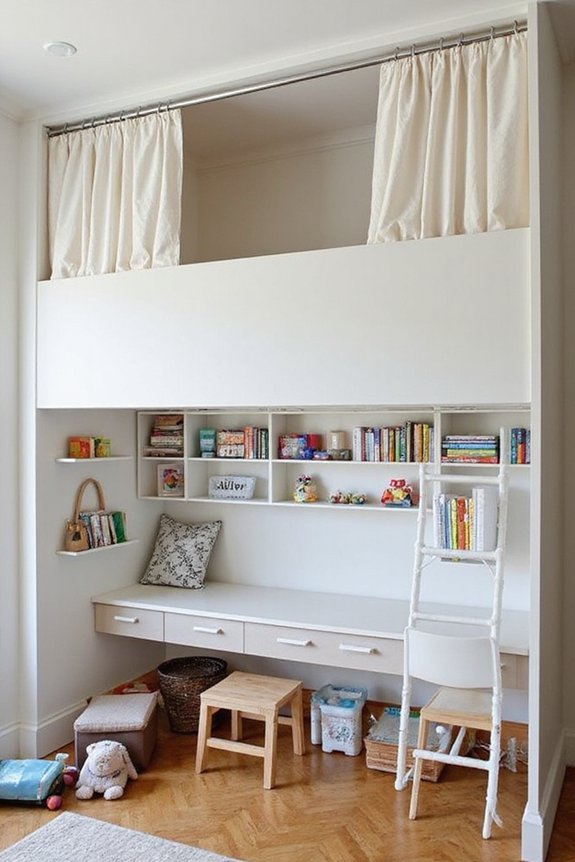
When floor space is at a premium, bunk beds offer the perfect solution for brothers sharing a room. You’ll instantly double your available play area while giving each boy his own defined sleeping territory.
The top bunk creates a natural fortress feeling that older kids love, while the bottom bunk provides easier access for younger children. Choose models with built-in storage drawers or shelving to maximize organization.
Consider L-shaped or perpendicular bunk configurations if your room layout allows – they create even more open floor space. This vertical sleeping arrangement eliminates bed-related disputes while promoting independent, personal spaces within shared quarters.
Label Everything to Eliminate Ownership Disputes

Nothing sparks sibling rivalry faster than disputed ownership of toys, clothes, and personal belongings in a shared bedroom. You’ll prevent countless arguments by implementing a clear labeling system that establishes boundaries and accountability.
Create distinct ownership markers using:
- Color-coded labels – Assign each boy a specific color for bins, drawers, and shelves
- Name tags – Use waterproof labels on clothing, backpacks, and personal items
- Photo labels – Add pictures for non-readers to identify their belongings instantly
- Zone markers – Use tape or decals to designate personal areas within shared spaces
This simple strategy transforms chaos into order while teaching responsibility.
Create Personal Display Areas for Individual Interests
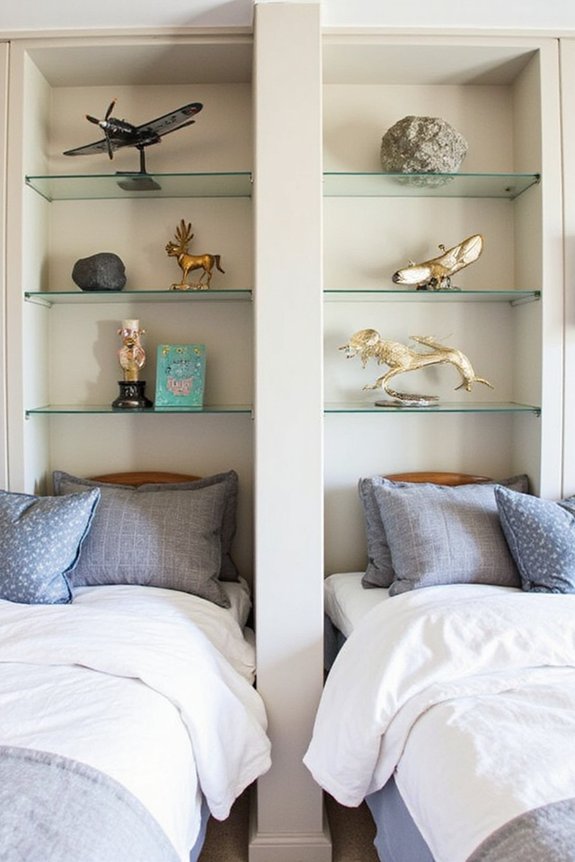
While shared bedrooms require compromise, each boy deserves dedicated space to showcase what makes him unique. Designate specific walls or shelves where each child can display their treasures—sports trophies, artwork, collections, or favorite books.
Install individual bulletin boards or magnetic strips for photos and achievements. Consider floating shelves at different heights to accommodate age differences. You’ll prevent territorial disputes when brothers know exactly where their personal items belong.
These display zones become sources of pride rather than conflict. When visitors comment on their individual showcases, you’ll see how personal space transforms rivalry into healthy self-expression and mutual respect.
Implement a Toy Rotation System to Reduce Clutter Conflicts

Cluttered bedrooms inevitably spark arguments between brothers competing for floor space and fighting over missing toys. You’ll transform this chaos by implementing a toy rotation system that keeps only select items accessible while storing others away.
Establish weekly rotation schedules where you swap out toys from storage bins. This strategy maintains novelty while reducing overwhelming clutter that triggers sibling disputes.
Essential rotation system components:
- Clear storage containers labeled with photos for easy identification
- Weekly swap schedule posted on their bedroom wall
- Neutral toy zones where sharing is mandatory
- Individual rotation bins for each brother’s special items
Set Up Designated Quiet Zones for Alone Time
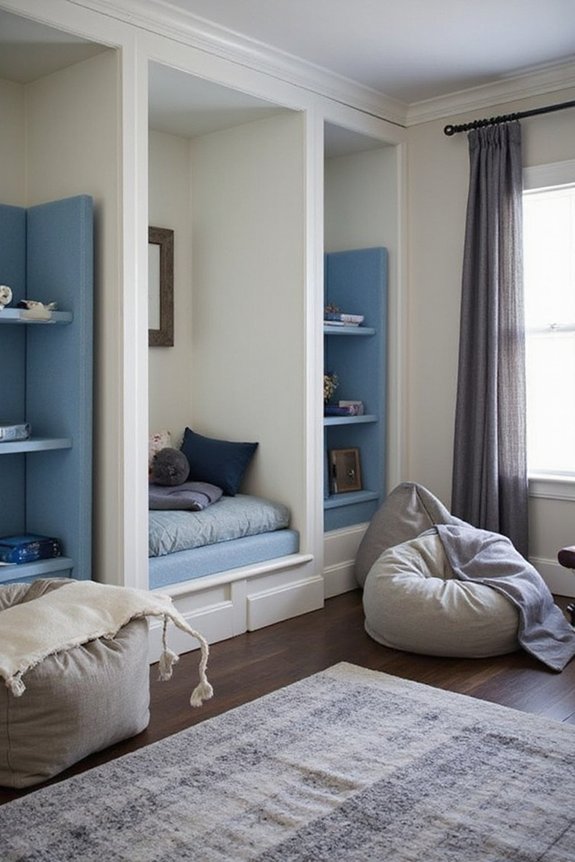
Even the closest brothers need moments of solitude to recharge, decompress, and pursue individual interests without sibling interference.
Create distinct quiet zones within your shared bedroom using room dividers, curtains, or strategically placed furniture. Designate specific areas where each child can retreat when they need space – perhaps a cozy reading nook with floor cushions or a small desk area with a privacy screen.
Establish clear rules about respecting these zones when someone’s using them. You’ll find that giving boys permission to have alone time actually reduces territorial disputes and creates a more harmonious shared living environment.
Conclusion
You’ve now transformed your boys’ shared bedroom into a diplomatic embassy worthy of the United Nations. With color-coded territories, labeled possessions, and designated quiet zones, you’ve fundamentally created a miniature apartheid system that’ll surely foster brotherly love. Who knew raising children required the organizational skills of a military strategist and the wisdom of Solomon? But hey, at least you’ll finally get some peace—until they unite against their common enemy: you.


